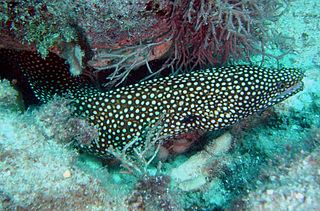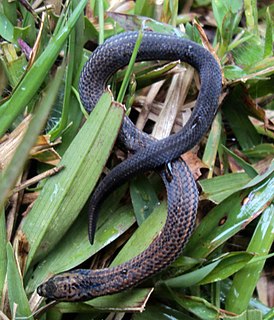
Narcinidae, or numbfishes, are a family of electric rays. They are bottom-dwelling cartilaginous fishes with large, rounded pectoral fin discs and long tails. They can produce an electric discharge for defense, from which their scientific name is derived.

Ilyophis is a genus of eels in the cutthroat eel family Synaphobranchidae.

The turkey moray ,also known as the guineafowl moray or as the white-mouth/whitemouth moray is a species of marine fish in the family Muraenidae.

Narcine is a genus of electric rays in the family Narcinidae. These species have a rounded pectoral fin disc and two dorsal fins, the first usually smaller than the second and placed behind the pelvic fin bases. The tail is longer than the disc and has a lateral fold. The spiracles are close behind the eyes, the nasal flaps are merged into a flap in front of the mouth. The teeth are nearly flat, with a central point.

The lesser electric ray, also known as the Brazilian electric ray, small electric ray, spotted torpedo ray, torpedofish or trembler, is a species of numbfish in the family Narcinidae found on the western coastal fringes of the Atlantic Ocean and Caribbean Sea. It is a small slow-moving fish, living in the surf zone of sandy or muddy beaches. Here it is easily caught as bycatch by shrimp fisheries and seine netters. The International Union for Conservation of Nature has rated it as being of "least concern".

Narcine timlei, the blackspotted numbfish, black-spotted electric ray, Indian electric ray, largespotted numbfish or spotted numbfish, is a species of numbfish in the family Narcinidae.

Narcine brasiliensis, the Brazilian electric ray or lesser numbfish, is a species of electric ray in the family Narcinidae. It inhabits coastal waters of the Southwest Atlantic from souther Brazil through Uruguay to northern Argentina.

The Tasmanian numbfish is a species of electric ray in the family Narcinidae. Endemic to southeastern Australia, this common ray inhabits shallow continental shelf waters in the southern portion of its range and deeper continental slope waters in the northern portion of its range. It prefers sand and mud habitats. This species can be identified by its spade-shaped pectoral fin disc with concave anterior margins, long tail with well-developed skin folds along either side, and plain dark brown dorsal colouration. Its maximum known length is 47 cm (19 in).
Aspidura brachyorrhos, commonly known as Boie's rough-sided snake and as ලේ මැඩිල්ලා in Sinhala, is a colubird species endemic to Sri Lanka. Bites from this species are known to cause mild local reaction, including a slight burning sensation and swelling.
Aspidura copei, commonly known as Cope's rough-sided snake or කලු මැඩිල්ලා in Sinhalese, is a species of snake in the family Colubridae. The species is endemic to Sri Lanka.
Aspidura drummondhayi, commonly known as Drummond-Hay's rough-sided snake or කෙටිවල් මැඩිල්ලා in Sinhala, is a colubrid species endemic to Sri Lanka.

Aspidura trachyprocta, the common rough-sided snake, known as දලව මැඩිල්ලා in Sinhala, is a colubrid species endemic to Sri Lanka.
Sicyopterus griseus, the Clown goby, is a species of goby endemic to India and Sri Lanka, where it is found in estuaries, blackwaters, and fresh waters. The populations within Sri Lanka is not yet internationally accepted, due to lack of evidences. This species can reach a length of 9.7 centimetres (3.8 in) SL.

The dusky sleeper or brown spinecheek gudgeon is a species of fish in the family Eleotridae found in many Indo-West Pacific regions, from the coast of eastern Africa to Hawaii, where it can be found in lagoons, estuaries, and freshwater streams with muddy bottoms. This species can reach a length of 26 cm (10 in).
Microphis ocellatus, the ocellated pipefish, is a species of fish in the family Syngnathidae. It is found only in Indonesia and Sri Lanka. The species measured 12.5 centimetres (4.9 in) SL in length.
Rhinobatos annandalei, or Annandale's guitarfish, is a type of ray. It is found in the Indian ocean around India, Pakistan, Sri Lanka and possibly the Persian Gulf. It is predominantly found in the marine waters, but also enters the brackish waters and freshwater rivers as well. It reaches a length of approximately 56 cm. They are ovoviviparous fishes.

The Ornate Aphid, or Violet aphid,, is an aphid in the superfamily Aphidoidea in the order Hemiptera. It is a true bug and sucks sap from plants. It is an invasive species.

Aenictus aratus is a species of beige and dark brown army ant found in Northern Australia. Parasitic depredation has been observed from Phoridae flies.
Aenictus asantei is a species of brown army ant found in Nigeria and Ghana. The species has been observed column raiding Pheidole juveniles. It is named for the Asante people.

Notiosoricini, whose members are known as the North American gray shrews, is a tribe of shrews in the family Soricidae, including the genera Megasorex and Notiosorex. They are found across the southwestern United States and most of Mexico.












